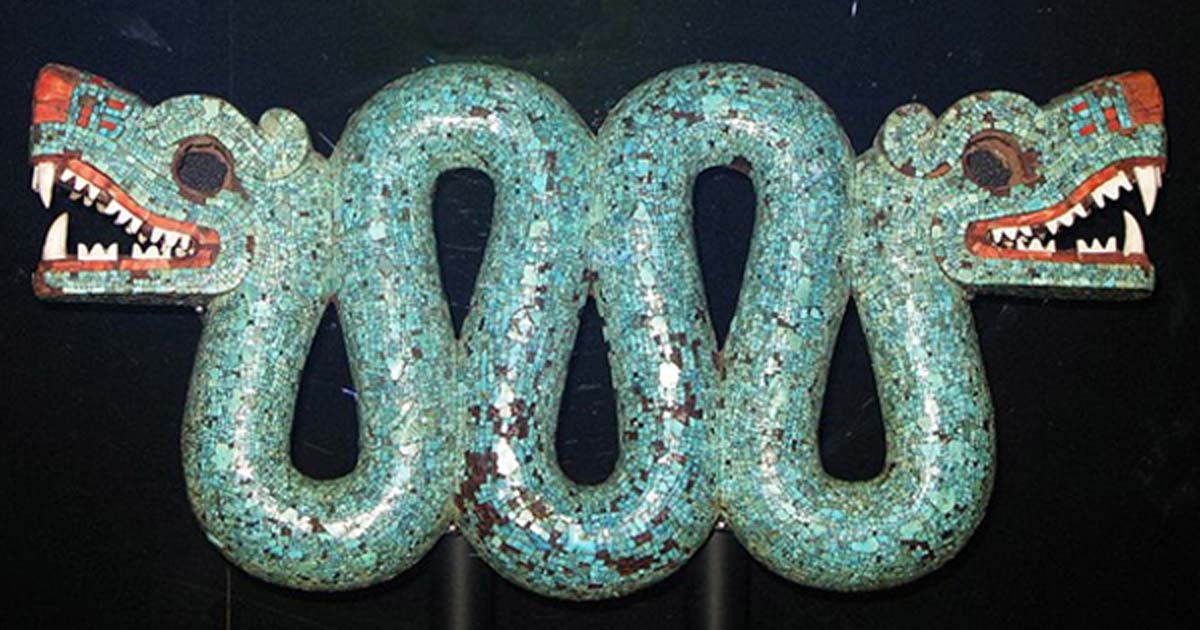True Origin of Ancient Turquoise Outstretches Previous Beliefs
New research published in the journal Science Advances overturns more than a century of thought about the source of turquoise used by ancient civilizations in Mesoamerica, the vast region that extends from Central Mexico to Central America. For more than 150 years, scholars have argued that the Aztec and Mixtec civilizations, which revered the precious, blue-green mineral, acquired it through import from the American Southwest. However, extensive geochemical analyses reveal that the true geologic source of Aztec and Mixtec turquoise lies within Mesoamerica.
Geochemist Alyson Thibodeau, assistant professor of earth sciences at Dickinson College, and a team of researchers from the University of Arizona, California State University at San Bernardino, and the Museo del Templo Mayor in Mexico City, measured the isotopic signatures of Mesoamerican turquoise artifacts associated with both the Aztecs and Mixtecs. These isotopic signatures function like fingerprints that can be used to determine the geologic origins of the turquoise.
- The Minaret of Jam – Last Monument of the Lost City of Turquoise Mountain
- Art of an Empire: The Imagination, Creativity and Craftsmanship of the Aztecs
- Tezcatlipoca: How Does the Supreme God of the Aztecs Compare to Other Omnipotent Deities?

A close-up view of Mixteca-style mask decorated with turquoise mosaic from the collections of the Smithsonian Institution-National Museum of the American Indian. Credit: Alyson M. Thibodeau
Specifically, Thibodeau and her research team carried out analyses of lead and strontium isotopes on fragments of turquoise-encrusted mosaics, which are one of the most iconic forms of ancient Mesoamerican art. Their samples include dozens of turquoise mosaic tiles excavated from offerings within the Templo Mayor, the ceremonial and ritual center of the Aztec empire, and which is located in present-day Mexico City. They also analyzed five tiles associated with Mixteca-style objects held by the Smithsonian's National Museum of the American Indian. The analyses revealed that turquoise artifacts had isotopic signatures consistent with geology of Mesoamerica, not the Southwestern United States.
"This work revises our understanding of these relatively rare objects and provides a new perspective on the availability of turquoise, which was a highly valued luxury resource in ancient Mesoamerica," said Thibodeau.
The work is the result of a decade-long collaboration between archaeologists and isotope geochemists to understand the nature of turquoise circulation and trade across southwestern North America. In earlier published research, Thibodeau showed that isotopic signatures could distinguish among turquoise deposits across the southwestern U.S. and identified the geologic sources of turquoise artifacts from archaeological sites in Arizona and New Mexico.
- Ancient Puebloan trade network much more extensive than previously believed
- Hathor, the Turquoise Goddess Near the Nile
- 3,000-Year-Old Copper Mask Found in Argentina Challenges Ideas of South American Metalwork Development

This is an image of a turquoise artifact linked to Canyon Creek. Credit: Courtesy of Saul Hedquist
Thibodeau said that long-standing assumption that Mesoamerican civilizations imported turquoise from the Southwest had not been fully substantiated with evidence and that the new geochemical measurements unveil a different story.
"These findings potentially re-shape our understanding of both the nature and extent of long-distance contacts between Mesoamerican and Southwestern societies,’ said Thibodeau. "I hope this inspires people to be skeptical of claims."
Top image: Aztec double headed serpent turquoise chest ornament, British Museum. Source: CC BY-SA 4.0
The article, originally titled ‘True origin of ancient turquoise’ was first published on Science Daily.
Source: Dickinson College. "True origin of ancient turquoise." ScienceDaily. ScienceDaily, 14 June 2018. www.sciencedaily.com/releases/2018/06/180614095248.htm
References
Alyson M. Thibodeau, Leonardo López Luján, David J. Killick, Frances F. Berdan, Joaquin Ruiz. Was Aztec and Mixtec turquoise mined in the American Southwest? Science Advances, 2018; 4 (6): eaas9370 DOI: 10.1126/sciadv.aas9370


















Comments
Last I checked, the American Southwest was part of Mesoamerica.
The view of ancient long distance trade has been very naïve. This is not how trade works. A natural abundance of commodity cascades to adjacent regions and eventually over considerable distance. When demand is established in a market huge distances away, these links become stronger and eventually become established. Merchants don't need to travel the total distance between point of origin and the ultimate market, it can be done through a network of exchange. By example, lapis lazuli originates in Afghanistan, however was found in trade goods throughout the med long before the silk road is considered to have been established. These single source commodities have to get to a different part of the world somehow!